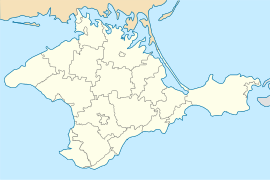| This article needs additional citations for verification. Please help improve this article by adding citations to reliable sources. Unsourced material may be challenged and removed. Find sources: "Tyritakē" – news · newspapers · books · scholar · JSTOR (October 2022) (Learn how and when to remove this message) |
| Τυριτάκη (in Ancient Greek) | |
 | |
 | |
| Location | Kerch, Autonomous Republic of Crimea/Republic of Crimea, Ukraine/Russia |
|---|---|
| Region | Taurica |
| Coordinates | 45°16′37″N 36°24′25″E / 45.27694°N 36.40694°E / 45.27694; 36.40694 |
| Type | Settlement |
| Area | 50 ha (120 acres) |
| History | |
| Builder | Settlers from Miletus |
| Founded | 7th or 6th century BC |
| Abandoned | Approximately 370 AD |
| Periods | Archaic Greek |
| Cultures | Greek |
| Site notes | |
| Condition | Ruined |
| Ownership | Public |
| Public access | Yes |
Tyritáke (Greek: Τυριτάκη) was an ancient Greek town of the Bosporan Kingdom, situated in the eastern part of Crimea, about 11 km to the south from Panticapaeum.
There are only few short mentions about Tyritake in ancient literary sources (Stephanus of Byzantium, Ethnika 642, 12; Pseudo - Aelius Herodianus, De prosodia catholica 315.12; Claudius Ptolemy, Geography 3.6.3.2; Ps. Arrian, Periplous Ponti Euxini 50,9 and Gaius Plinius Secundus, NH 4, 86-87 who names the city as Dia). The first serious excavations of the town started in 1932 (headed by J. Marti) and have been followed in 1946-1957 by great Bosporan Expedition headed by prof. V. Gaidukievich. In 70s and 80s the territory of Tyritake was excavated by an expedition from the Kerch Museum headed by D. Kirilin and O. Shevelev and since 2000 the project "Bosporan City Tyritake" directed by prof. V. Zin'ko. In 2008 the Polish Archaeological Mission Tyritake of National Museum in Warsaw, with Alfred Twardecki as director, joined the project.
All these archaeological projects were able to establish that the colony, founded about the mid-6th century BC, specialized in crafts and viticulture. In the first centuries AD, fishing and wine production became the economical mainstay of the town. Tyritake was sacked by the Goths in the 3rd century AD and again in the 4th century by the Huns, but a settlement on the site continued into the Middle Ages.
See also
References
- Braund, David (2022-03-31). "Tyritake: a Pleiades place resource". Pleiades: a gazetteer of past places. Brady Kiesling, Sean Gillies, Johan Åhlfeldt, Jeffrey Becker, Tom Elliott, DARMC. Retrieved 2022-10-03.
- "Polish archaeological mission "Tyritake" | National Museum in Warsaw - Kerch Museum". 2011-08-19. Archived from the original on 2011-08-19. Retrieved 2022-10-03.